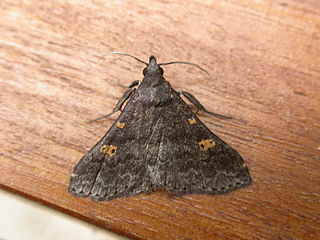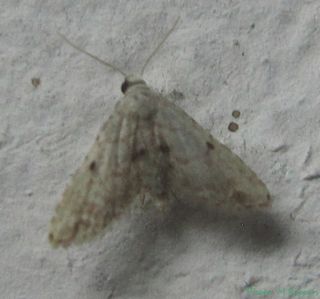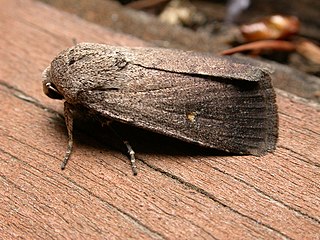
Naarda is a large genus of erebid moths currently encompassing 108 species. Initially identified by Francis Walker in 1866, it is in the family Erebidae. Somewhat ruddy in appearance, this genus is distinguishable for its generally slender thorax and abdomen, and straight, porrect labial palpi. Most species are a light tan color, but shading can reach as deep as a charcoal, with muddy yellow, conspicuous reniform, orbicular stigmata featured on the forewings, sometimes reflected bilaterally superior.
Aethalina is a monotypic moth genus in the family Erebidae. Its only species, Aethalina asaphes, is found in Queensland, Australia. Both the genus and species were first described by Turner in 1902.

Araeopteron is a genus of moths of the family Erebidae. The genus was erected by George Hampson in 1893.
Elaphristis is a genus of moths of the family Erebidae. The genus was erected by Edward Meyrick in 1891.
Eporectis is a genus of moths of the family Erebidae. The genus was erected by Edward Meyrick in 1902. Both species are found in the Australian state of Queensland.
Lophotoma is a genus of moths of the family Erebidae. The genus was described by Turner in 1902.

Mormoscopa is a genus of moths of the family Noctuidae.

Proteuxoa is a genus of moths of the family Noctuidae. The genus was erected by George Hampson in 1903.
Habrophylla is a genus of tussock moths in the family Erebidae. The genus was described by Alfred Jefferis Turner in 1921. All the species are found in Australia.
Homospora is a monotypic moth genus in the family Geometridae described by Turner in 1904. Its only species, Homospora rhodoscopa, was first described by Oswald Bertram Lower in 1902. It is found in Australia.

The Depressariinae – sometimes spelled "Depressiinae" in error – are a subfamily of moths in the superfamily Gelechioidea. Like their relatives therein, their exact relationships are not yet very well resolved. It has been considered part of family Elachistidae sensu lato or included in an expanded Oecophoridae. In modern classifications they are treated as the distinct gelechioid family Depressariidae.
Gastridiota is a monotypic genus consisting solely of Gastridiota adoxima, a moth of the family Bombycidae. The genus was erected by Alfred Jefferis Turner in 1922 but the species had been described by him in 1902 as Andraca adoxima. It is found in the subtropical east of Australia, from the Bunya Mountains and Montville in southern Queensland to north-eastern New South Wales.

Alapadna pauropis, the variable spot-wing, is a species of moth of the family Noctuidae first described by Alfred Jefferis Turner in 1902. It is found in the Australian states of Queensland, New South Wales, Victoria and Tasmania.

Etanna clopaea is a species of moth of the family Nolidae first described by Turner in 1902. It is found in Australia, including Queensland, New South Wales and the Australian Capital Territory.

Xyloryctidae is a family of moths contained within the superfamily Gelechioidea described by Edward Meyrick in 1890. Most genera are found in the Indo-Australian region. While many of these moths are tiny, some members of the family grow to a wingspan of up to 66 mm, making them giants among the micromoths.

Calathusa is a genus in the moth family Erebidae, erected by Francis Walker in 1858. Many of its species occur in Australia. This genus is sometimes included in the subfamily Chloephorinae and sometimes in Hypeninae.

Doratifera is a genus of cup-moth caterpillars in the family Limacodidae. The genus was erected by James Duncan in 1841. There are about 13 described species in Doratifera, found primarily in Australia. They are called cup-moths because of the shape of their cocoons. In the species Doratifera vulnerans, the venon has a complex structure having 151 different protein-based toxins produced from 59 distinct protein families. The venom can be used in pesticides and drugs.

Antipterna is a genus of moths of the family Oecophoridae, first described by Edward Meyrick in 1916.











